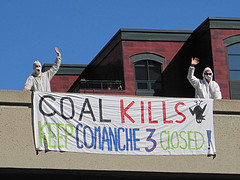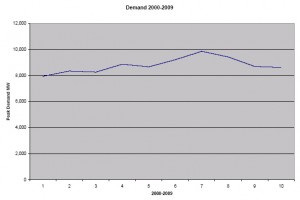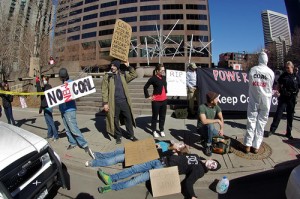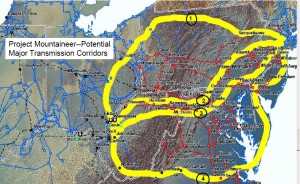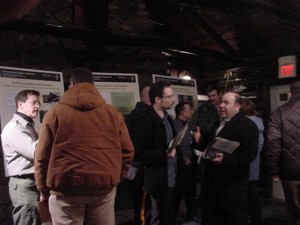Xcel’s 10-K and a die-in!
February 26th, 2010
***********************************************
I just got a tip on what looks like a great book:
The Grid: A Journey Through the Heart of Our Electrified World
***********************************************
XCEL’s 2009 10-K just came out, and demand is down, down from 2008, but unfortunately not all that much… maybe next year!
And that, folks, is Xcel’s peak demand, from 2000 through 2009.
Now, if someone will only tell me how to label the X axis… I cannot figure it out. “1” is 2000, “2” is 2001, etc…
And about that die-in, hot off the “press” from Ted Nace:
Local Citizens ‘Die-in’ at Xcel HQ in Coal Protest
Group calls on Xcel to Keep Comanche 3 Closed and Produce 100% Renewable Electricity by 2020
February 26, 2010
Denver, CO – At 11:45am on Friday, February 26th, local citizens demonstrated at the Denver headquarters of Xcel Energy – located at the corner of 17th St. and Lawrence St. – in protest of the utility’s impending plan to bring a new coal-fired power plant online in Pueblo, CO. The lunch hour protest called on Xcel executives to move Colorado in the right direction by keeping the Comanche 3 coal-fired power plant closed. Protestors demonstrated in a ‘die-in’ in front of the building’s main entrance to highlight the grim consequences that coal has on our lives and those of future generations. Simultaneously, two activists clad in hazmat suits dropped a banner off an adjoining bridge on Lawrence St. Police arrived on scene but no arrests were made.
The 750-megawatt Comanche Unit 3 would be the largest coal-fired power plant in the state, surpassing even the mammoth Cherokee coal plant in North Denver. “At a time when the costs of coal are becoming increasingly clear and the benefits of clean energy are ever more apparent, building the largest coal-fired power plant in the state is taking us 180 degrees in the wrong direction,” said Amy Guinan, an activist with Power Past Coal.
According to Xcel’s own data, the Comanche 3 plant would emit over 20 million pounds of CO2 a day, 2 pounds of mercury a week and thousands of tons of particulates and haze forming pollutants every year. The plant would also consume over 4 million gallons of water a day.
“Xcel has already wasted nearly $1 billion on this planet-destroying boondoggle. Operating it could cost ratepayers billions more. For the sake of Colorado’s children, and future generations, it is time for Xcel to pull the plug on this ill-conceived coal plant and redirect their investments towards making Colorado 100% renewable,” said Tom Weis, President of Wind Power Solutions.
Xcel has had ongoing problems bringing the plant online. While Xcel originally hoped to bring the plant into operation last fall, a variety of technical problems – currently involving a boiler pump – continue to push back its scheduled opening.“There are a lot more than just technical problems with this new coal-fired power plant. There are serious social, economic and environmental problems. Rather than talking about a delayed opening, we should be talking about a permanent closure. Instead of building a new coal-fired plant, Xcel should be investing heavily in Colorado’s abundant solar and wind resources,” said Brian Bernhardt, an activist with Power Past Coal.
Today’s protest is part of an ongoing series of actions to move Colorado beyond coal. Sparked by the failure of elected and appointed officials to take meaningful action to move rapidly to renewable energy, the Power Past Coal campaign is building a grassroots protest effort. With the Colorado Department of Public Health and Environment approving the permit-to-pollute for both the Valmont and Cherokee stations despite overwhelming public opposition, citizens are prepared to ramp up the pressure on Xcel executives, as well as Colorado politicians and regulatory agencies.
“Our leaders are failing to lead and Xcel is failing to take their responsibility seriously. Xcel should expect more protests and actions unless they start closing down coal plants and moving Colorado to 100% renewable electricity,” Kate Clark, a Power Past Coal activist.
Xcel has been challenged on multiple fronts this week. On Tuesday evening, Pueblo residents – where the new coal-fired power plant is built – raised serious concerns about high-pitched noises from the plant which are affecting people as far as nine miles away. Meanwhile, WildEarth Guardians petitioned the U.S. Environmental Protection Agency to protect clean air and the climate and overturn an air pollution permit allowing Xcel Energy to illegally pollute while operating the Pawnee coal-fired power plant.
Tom Micheletti in Sen. Amy Klobuchar’s office?
February 25th, 2010
So what is Tom Micheletti doing in Senator Amy Klobuchar’s office?
Why is Senator Klobuchar entertaining more stories, fiction like “The Virtues of Coal Gasification in Northern Minnesota?”
Enough of Klobuchar and her pandering to fossils and their fuel – time to vote her OUT!
Feasibility of Undergrounding 500kV Lines
February 24th, 2010
I just found this, from the Alberta Electric System Operator, and will put more up about it tomorrow:
Feasibility Study for 500kV AC Underground Cables
FERC cost-apportionment docket heats up
February 24th, 2010
The cost apportionment remand at FERC is heating up. It’s that case where the 7th Circuit threw out the PJM cost apportionment scheme:
It went back to FERC and so FERC issued an Order requiring PJM to produce things that… well… things that will demonstrate that there’s no need for this project, things that will demonstrate the benefactor of these transmission lines, things that PJM doesn’t really want the world to know, like how they’ve incorporated O-P-T-I-M-I-Z-A-T-I-O-N, things going directly to N-E-E-D!
Seeing that, well, Stop the Lines had to join in, as did the Municipal Intervenors:
PJM begged for more time, an extension of 45 days!
And for some bizarre reason, FERC gave it to them:
Meanwhile, Exelon wants to bring in the kitchen sink, including 345kV transmission:
And parties they are a freakin’ and filing:
And then the weirdest of all – the American Wind Energy Ass (AWEA) wants to intervene, citing “the current significance of this issue in the context of efforts to build transmission to bring location-constrained, renewable resources to load…” Ummmm… SAY WHAT??
OK, I give up… in what parallel or alternate universe is the PATH or Susquehanna-Roseland line for wind? WHERE DO THEY GET THESE IDEAS? I want to see the basis for that statement. PRODUCE!
Earth to AWEA — can you spell P-R-O-J-E-C-T M-O-U-N-T-A-I-N-E-E-R?
If you need a hint, go to FERC eLibrary and search for A05-03. Happy reading!
NPS scoping hearings in progress
February 18th, 2010
Scene from yesterday’s NPS meeting at Camp Jefferson, Lake Hopatcong, NJ
PSEG’s Susquehanna-Roseland transmission line through the Delaware Water Gap is under scrutiny.
Just out – PSEG year end info (just searched SEC and don’t see it there yet):
And for some reason, I get that old hook line, a little perverted, i.e., “We gotta lock down our electric revenue, and then we’ll take it higher!”:
Yesterday was the second of three public comment hearings that the National Park Service is holding regarding PSEG’s application to expand the Right of Way and run its Susquehanna-Roseland through the Delaware Water Gap, a premier federally designated “wild and scenic” area. The good news is that people are really turning out, the first meeting, in Bushkill, PA, was about 100, and this meeting was twice that, standing room only in the log hall of Camp Jefferson.
Here is the NPS’ take on framework and issues for the Environmental Impact Statement:
Here’s a few snippets that I really find interesting — and of course want to expand on:
Air Quality
Construction and maintenance activities would impact air quality.Viewsheds
The new transmission lines and associated roadways would affect the visual viewshed. Viewshed impacts would be permanent. A separate viewshed analysis should be done for scenic and visual impacts. A comprehensive list of the viewsheds at DEWA does not exist at this time. However, the APPA is considered a scenic viewshed. The baseline conditions are represented by the current viewshed, which has not yet been evaluated.Climate Change/Greenhouse Gases
How the project contributes to the production of greenhouse gases and climate change, as well as how climate change would impact the project and park resources must be addressed in the EIS.Viewshed Appreciation
The new transmission lines and associated roadways could adversely affect the visitors’ appreciation of the visual viewshed. These impacts would be permanent. A separate viewshed analysis should be done for scenic and visual impacts for visitor experience.
The one that jumps out to me is “air quality.” I note that under “Climate Change/Greenhouse Gases” they acknowledge the project contribution of greenhouse gas and climate change, and that also needs to be added to the Air Quality section, the project contribution of pollutants to air quality.
Why? Check the RTEP, PJM’s 2007 RTEP that this Susquehanna-Roseland project was based on:
Critical RTEP Issues and Upgrades
PJM continues to address a number of issues with
a bearing on reliability in Pennsylvania and the
regional transmission expansion plans required to
maintain it:• Increasing power transfers through Pennsylvania to feed eastern Mid-Atlantic PJM load centers including those in Pennsylvania are expected to cause overloads beginning in 2016 on key circuits in Pennsylvania. New high voltage backbone facilities are required to mitigate these reliability issues. The new backbone facilities will also be assessed for their ability to support deliveries from a cluster of new coal-fired generating facilities currently proposed for central and northeastern Pennsylvania. Three major new backbone transmission facilities have been approved by the PJM to resolve growing reliability criteria violations in eastern Mid-Atlantic PJM and west/central Pennsylvania, upgrades that are now part of PJM’s RTEP:
• Susquehanna – Lackawanna – Jefferson – Roseland 500 kV circuit
• Amos – Bedington – Kemptown (PATH) 765 & 500 kV circuit
• Mid-Atlantic Power Pathway (MAPP): Possum Point – Calvert Cliffs – Indian River – Salem 500 kV Circuit
2007 RTEP, p.259-260 (emphasis added)
Beginning on p. 262, the RTEP lists 2,712 (check my math) of coal in queue. Yup, Susquehanna-Roseland could handle that! Here’s the full PA chapter of the 2007 RTEP — see for yourself:
The New Jersey one says essentially the same thing:
Those new coal plants and the impacts of facilitating/enabling those new coal plants and the impact on the Class I park must be addressed. The operational impacts, contributions to greenhouse gases, applies equally to air quality. This was an issue with Voyageurs National Park in the Mesaba Project review, and it should be here.
Here’s the “study area” designated by National Park Service – the “no data” spot is Picatinny Arsenal. What happens if you build transmission over an arsenal? What is the impact on the park if Picatinny Arsenal goes BOOM!?!?!
Here are some articles, thanks to Scott Olson ( Fired up and ready to go one more time! ) for compilation:
- Last stand: Critics slam power line plans across Delaware Water Gap, Appalachian Trail (Daily Record)
- Crowd of 200 puts Park Service on notice (New Jersey Herald)
- N.J. residents, environmentalists urge National Park Service to reject proposed $750M power line (Star-Ledger)
- New Jersey residents make plea to National Park Service to oppose power lines project (The Express-Times)
